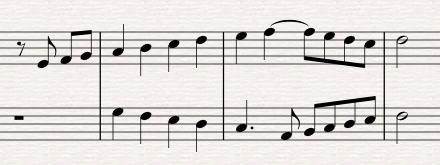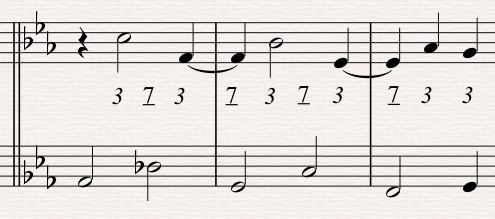counterpoint
Counterpoint is one of the most rewarding and rich textures in music. Good counterpoint is beautiful, interesting and intellectually stimulating. The great composers throughout history, from Bach and Mozart, Debussy and Stravinsky, John Williams and Jerry Goldsmith, all share the common trait of a mastery of counterpoint.
We’ll be taking a crash course through the concepts of counterpoint. We’ll learn the basics of consonance vs. dissonance, the different types of motion between two voices, and general guidelines for writing effective counterpoint.
The problem with most counterpoint books and courses is that the only thing they know how to do is teach you to write something like this:

Unfortunately, not many people really listen to music like that anymore. Sure, it is brilliant writing and it sounds great, but it’s old fashioned (and I mean REALLY old fashioned. Even people in the late 1700s considered it out of style!). Could you imagine trying to score an action scene with something like that? Or what if the Black Eyed Peas came out with that as their latest single? For a brief moment they might be considered “brilliant”, but it wouldn’t last much longer than a fad.
As a result of teaching people how to write music from the mid-18th century, most people who try dabbling in counterpoint give up. They come to the conclusion that the methods are outdated and out of touch, that their music shouldn’t have to live by all these “rules”, and that studying the art of counterpoint is meaningless.
Well I’m here to argue that counterpoint is an absolutely crucial skill for any aspiring composer/songwriter/music creator to learn, internalize and incorporate in their music. And it will not require that you take a few semesters at a conservatory to understand, either. Just a few basic guidelines are enough to get you started.
What I’ve found is that although the specific rules and methods of traditional counterpoint are a hindrance to most students’ learning, if you can understand some of the most basic concepts you will be well on your way to writing counterpoint in your music that is effective and meaningful.
What is Counterpoint?
Counterpoint refers to two or more independent melodies that sound good when played at the same time. Counterpoint is also often referred to as Polyphony.
Here is an example of what we are not calling counterpoint:

Yes, there are two independent lines, but the figure in the left hand is simply an arpeggio pattern that serves as accompaniment and is subordinate to the melody in the right hand. Remember that in counterpoint there is an emphasis on independence. Even if one line is more interesting and attracts more attention (which is very often the case), the other line still should sound good on its own.
In this tutorial we’re going to be working with tonal music. Chromaticism is gladly welcome, but in general I’m assuming most of you reading this are more likely to prefer Michael Giacchino and Coldplay over Shoenberg and Varese.
Voices
In this tutorial we’re going to be talking primarily about two-part or 2 voice counterpoint. Although you will find plenty of examples of 3, 4 and more voices, 2 voice counterpoint is the simplest and the most important to learn.
A “voice” does not literally refer to a human voice, but to a single melodic line. If you have two melodies happening at the same time, you have to distinct voices.
One voice:
![]()
Two voices:

Four voices: 
The number of voices in a piece is not the same as the number of instruments. You could have 100 players of a massive orchestra playing the exact same melody and it would be considered a single voice.
Intervals
Before going any further it is critical that you have a strong understanding of intervals. You should be able to tell the difference between a perfect 5th and a diminished 5th, a minor 3rd and a major 3rd, etc. If the concept is new to you or you need a refresher, I suggest you pause now to read This tutorial. Most of what we’ll be doing is analyzing the intervals between the two voices, so it’s of the utmost importance that you can do this fluently and effortlessly.
Consonance vs. Dissonance
One of the main concepts we’ll be dealing with is that of consonance vs. dissonance.
From thefreedictionary.com:
- con·so·nance (kns-nns) – Agreement; harmony; accord.
- dis·so·nance (ds-nns) – Lack of agreement, consistency, or harmony; conflict.
In crude and basic terms, consonances sound good and dissonances sound bad. More elegantly, dissonances tend to sound harsh and tense while consonances tend to sound pleasant and restful.
Which intervals are consonant and which are dissonant is largely a matter of taste and context, but the general consensus in tonal music is this:
- Unisons, octaves, 5ths, 3rd and 6ths are consonances
- 2nds and 7ths are dissonances
- 4ths and tritones can be either consonant or dissonant depending on context
Dissonances can then be broken down even further:
- Major 2nds and minor 7ths are soft dissonances
- Minor 2nds and major 7ths are harsh dissonances
Compounds (intervals greater than an octave) are treated the same as their shorter equivalents (ie. 9ths are treated as 2nds, 10ths as 3rds, etc.)
Types of Motion
In counterpoint there are three kinds of motion:
Parallel motion: both voices move in the same direction. From the Rite of Spring:
![]()
Contrary motion: both voices move in the opposite direction. From Wagner’s prelude to Die Meistersinger von Nürnberg:

Oblique motion: one voice moves while the other stays constant. From Beethoven’s Rondo in C minor:

Species Counterpoint
It’s worth mentioning that traditional methods generally break the study of counterpoint down into 5 “species”. Each species refers to how many notes in one voice are playing against how many notes in the other voice. For example:
- The first species is a single note against another single note. If you have quarter notes in the top voice, you have quarter notes in the bottom voice.
- Second species counterpoint is two notes against one. If you have quarter notes in the top voice you have eighth notes in the bottom voice.
- Third species is four notes against one. Quarter notes in one voice means 16ths in the other.
- Fourth species counterpoint is all about suspensions and syncopations.
- And finally the fifth species, called “florid counterpoint”, which is essentially a free combination of the first four.
Now that I’ve gone through and explained all that: I’m not going to go through one species at a time. A methodical system of building one complexity on top of another makes perfect sense, but this is a crash course and we’ve got notes to write! Instead the guidelines that I outline should be considered for all types of counterpoint, regardless of how many notes you have against how many other notes. The purists among you may not like it, but we’re not writing our thesis piece for a masters in composition. We’re just trying to get close enough for jazz.
Guidelines
Now that we have the basic concepts of consonance vs. dissonance and the 3 types of motion we can begin to set out some guidelines for good counterpoint. I call them “guidelines” because there are obviously no rules in a creative art like music. But if you want to learn how to make your counterpoint effective it is strongly advised that you adhere to the guidelines until you can consciously and purposefully choose to go against them.
Independence Between Voices
The main purpose of counterpoint is to have two separate but equal melodies playing simultaneously. Separate means they they peak and valley in different places and that they move at different times. Equal means that they are both interesting lines in their own right, that if they were to be played alone there would be a sufficient sense of melodic contour and interest.
These two lines come from Debussy’s Prelude to the Afternoon of a Faun:

Listen to just the top voice:
And now just the lower voice:
Notice that although they work well together, they are also interesting in their own right. Also notice the contrast of movement. When the violins have 16th notes the winds have quarter and 8th notes. When the violins rest the winds becomes more active.
A Balance of the Three Types of Motion
Earlier we saw that there are three types of motion between voices: Contrary, Parallel and Oblique. Strong counterpoint uses a balance of all three types.
In general contrary motion is the most preferred, as it creates the greatest amount of independence.
Oblique motion is very effective when alternating between voices, but should used sparingly if you are keeping the same pitch constant in a single voice. You then end up featuring one voice and making the second voice seem much less important and interesting.
Here is an effective use of alternating oblique motion from Beethoven:

As we’ll see further down, parallel motion should generally be reserved for 3rd and 6ths. Parallel motion creates a great contrast from too much contrary and oblique motion, but you have to be careful to avoid having too much of it or you lose independence between voices.
Notice how in this example from Debussy’s Fêtes that although there are 5 separate voices, because they all consistently move in parallel they give the impression of a single unit:

To create true independence between voices, as opposed to a single functioning block, we need to mix up the use of motion. These clarinet and bassoon lines from Stravinsky’s Fire-bird share similar motives but clearly have an independence of direction:

A Balance of Consonance and Dissonance
Our next consideration will be a balance of consonance and dissonance. Too much consonance can be fluffy and dull:

Too much dissonance can be ugly and hard to comprehend:

Deciding what precisely this “balance” is will be completely up to the intentions and tastes of the composer.
Let’s take two examples that are different in style and compare their balance of consonance vs. dissonance. The first comes from Schumann’s Album for the Young:

The second example is from Bartok’s Mikrokosmos:

The interesting thing about these two very stylistically different phrases is that they actually have a reasonably similar ratio of dissonance to consonance (7:25 in the Schumann, 8:21 in the Bartok). The Bartok, however, definitely has more dissonance (20% in the Schumann compared to 28% in Bartok). Both examples tend to rely on mostly consonant intervals, using dissonances as extra “spice”. Notice also how the dissonances are spaced apart from one another.
A Balance of Intervals
Just as you need balance in all other areas, a balance of interval types helps keep your lines interesting.
- 3rds and 6ths should be generally favored (steak)
- 5ths and octaves should be used a bit less (potatoes)
- Dissonances should be used sparingly (salt and pepper)
Listen to this example from Mahler’s 4th Symphony and note the complete mix of interval types (it’s also a brilliant example of independent rhythms):

Avoid Parallel and Direct 5ths and 8ths
This is one of the most difficult rules for beginners to follow because at first glance it doesn’t seem to make a lot of sense. The rule is that when two voices move in the same direction, they should not move into an interval of a 5th or an octave.
The reasoning behind this rule is that the octave and 5th are primal intervals. Having two unique voices move in parallel motion at the octave or 5th gives the impression that they are actually the same melody. So if your two voices move in parallel at the 5th or octave, you are essentially violating the whole idea of counterpoint which is to have two independent and separate voices.
The problem students run into is that parallel 5ths and octaves are very difficult to hear with an untrained ear. My only advice is to follow this rule on faith, because as your ears and your counterpoint skills develop you will eventually learn to hear parallel 5ths and octaves and they will indeed sound wrong to you.
I’m sure you’ll find this rule “broken” in plenty of examples. One of the main exceptions to this rule is that parallel 5ths and octaves at the end of a phrase (ie. into a cadence) are considered acceptable, probably because the punctuation of the cadence makes the effect much less bothersome.
Dissonances Should Resolve
In general, a dissonant interval should resolve to a consonant interval. This means that if you are using a dissonance for a bit of spice and creating tension, it is only going to really be effective if you then release that tension. Otherwise it’s probably just going to sound like you played a wrong note!
The easiest way for a dissonance to resolve is to keep one pitch constant and moving the other pitch into a consonant interval. Let’s look at the Beethoven example we used earlier when showing oblique motion:

Notice how every dissonance is first introduced as a consonance, then a new note makes the interval dissonant, and finally it resolves back into a consonance. If you listen to the string writing of Harry Gregson-Williams you will hear this technique being used all over the place.
Outer Voices
Two-part counterpoint is great and all, but most real music uses more than two voices. If you’re breaking out into using multiple parts, the most important thing to pay attention to is the counterpoint between the outer voices. The top and bottom voices are the ones that are going to be heard the most, so that is where your focus should be when writing good lines. The rest of the voices can then be used to “fill in the spaces” of the harmony.
Listen to this example from Brahms’ 4th Symphony:

Now listen to just the top and bottom voices:

We still get essentially the same musical effect. The 1st violins with the top voice and cellos and basses on the bottom voice create an interesting and effective counterpoint. The 2nd violins and violas then serve to fill out the chords, with less of an emphasis needed for making them independent and interesting lines.
